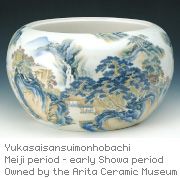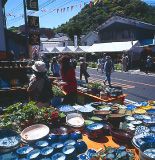


Gottfried Wagner who contributed to the modernization of the ceramic industry in Japan and exerted a great influence on Arita Gottfried Wagner, a German chemist, was invited to Arita in 1870 (Meiji 3) to impart the European knowledge of ceramics. He stayed in Arita only for four months, when the potters there learned a lot about Western ceramic techniques from him. One example was the Western-style coal-fueled kiln. Traditionally, in many cases, climbing kilns fueled with firewood had been established on the slopes of mountains. The first attempt in Japan to fire ceramics in a kiln established on flat ground and fueled with coal was made in Arita. With this experiment as a start, coal-fueled kilns spread throughout Japan from the latter half of the Meiji onward.  Wagner also contributed to the improvement of the paints used in Arita. He taught the method of using industrially refined cobalt instead of the natural mineral cobalt (gosu) from China that had been traditionally used to make the deep blue color for underglaze wares. The new cobalt spread nationwide in a few years because its use provided a brighter blue color, made shading more controllable, and saved money. In the traditional potteries it was not easy to change machinery that was involved in the production system, while paints were an element of the production processes. This is why the artificially produced cobalt spread so rapidly.
Wagner also contributed to the improvement of the paints used in Arita. He taught the method of using industrially refined cobalt instead of the natural mineral cobalt (gosu) from China that had been traditionally used to make the deep blue color for underglaze wares. The new cobalt spread nationwide in a few years because its use provided a brighter blue color, made shading more controllable, and saved money. In the traditional potteries it was not easy to change machinery that was involved in the production system, while paints were an element of the production processes. This is why the artificially produced cobalt spread so rapidly.After leaving Arita, Wagner taught ceramic chemistry in universities in Tokyo and Kyoto and researched new production methods for ceramics as well. |

|
|
 The first ceramics competition show was held in Keiunji temple sponsored by Koransha President Eizaemon Fukagawa and Teiichi Tashiro, president of the Arita Porcelain Ceramic Association in March of 1896 (Meiji 29). Since then a competitive show has been opened annually and in 1948 (Showa 23) the period was fixed to be from April 29 to May 5.
The first ceramics competition show was held in Keiunji temple sponsored by Koransha President Eizaemon Fukagawa and Teiichi Tashiro, president of the Arita Porcelain Ceramic Association in March of 1896 (Meiji 29). Since then a competitive show has been opened annually and in 1948 (Showa 23) the period was fixed to be from April 29 to May 5.